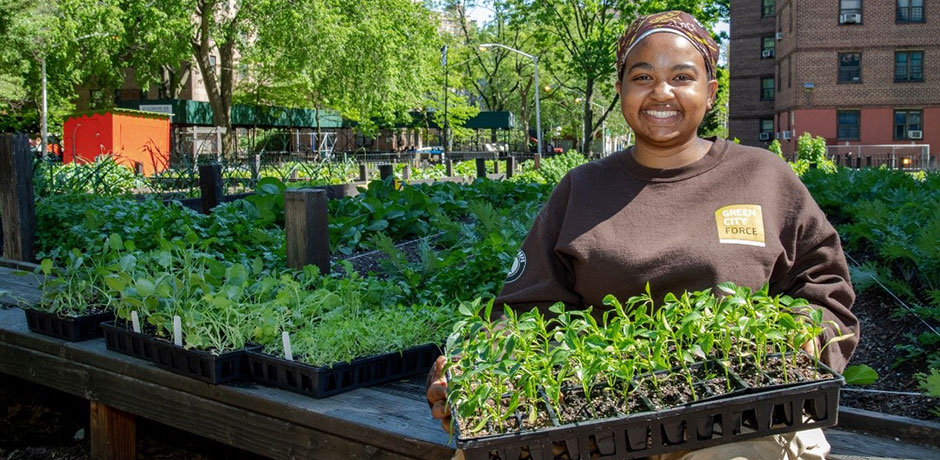The Of City Blooming
The Of City Blooming
Blog Article
Fascination About City Blooming
Table of ContentsRumored Buzz on City BloomingSome Known Factual Statements About City Blooming City Blooming Things To Know Before You Get ThisA Biased View of City BloomingFacts About City Blooming Uncovered
Intrigued in growing food to buy in the City of Chicago? Considering beginning an area yard? Changes to the Chicago Zoning Statute enable agricultural uses like neighborhood gardens and metropolitan ranches in lots of components of the city. Below is a checklist of often asked inquiries relating to the rules and policies that growers ought to consider when preparing an urban farming job.
The zoning change does not customize any type of other codes managing composting, building permits, purchasing or leasing City possessed property, organization licenses or environmental contamination. There are existing codes that control these concerns and they stay in full impact and may apply to your project. Neighborhood gardens are generally owned or handled by public entities, civic organizations or community-based organizations and kept by volunteers.
Urban farms expand food that is planned to be sold, either on a nonprofit or for-profit basis. As a result of their commercial purpose, city ranches require a service certificate. Yes. An area yard is permitted to market surplus generate that was grown on website if the sales are accessory or subordinate to the garden's primary function explained over.
The smart Trick of City Blooming That Nobody is Discussing
Composting is enabled yet just for plant product that is generated and made use of on website. The quantity of compost material can not surpass 25 cubic backyards at any kind of given time according to the standards in 7-28-715 of the City's Municipal Code. Yes. Because the dirt at a lot of new garden sites needs amending, compost, soil, wood chips, or other products can be acquired to construct or boost the growing area - indoor plants.

If a structure license is required after that the hoophouse will certainly be thought about an accessory building. You can figure out even more about the building license needs by calling the Department of Structures. The 25,000-square-foot dimension limit is meant to avoid a single community garden from controling an offered block or taking away from the block's existing household or commercial character.
The restriction does not use to yards located in Public Open Area (POS) districts. Can there be more than one area yard that is 25,000 square feet on a solitary block? Fence is not required, nonetheless, gardens that have huge car parking areas may be called for to set up fencing or other landscaping functions.
Our City Blooming PDFs
B1 & B2 areas need that all commercial usage tasks be performed indoors. R districts restrict commercial activity. The guidelines reflect the objective and intent of the Zoning Code. Is fencing needed for metropolitan farms? Yes. Fencings may be required, in addition to landscaping and screening, for sure car parking locations and outdoor job or storage locations depending upon location and the specific activity happening.
Urban farms require building licenses and zoning approvals prior to building and construction (balcony and patio garden design). Various other forms of city evaluation may be required depending on details frameworks, activities, dimension, landscaping, licensing, public heath and stormwater management issues.
The Department of Organization Affairs and Consumer Protection can assist identify the particular kind of business license that's called for. Off road car park is required for most business tasks in Chicago. The needed number of car park areas is based on the number of employees functioning on site and not the square video footage of the expanding space.
City Blooming - An Overview

Yes. An urban ranch can sell compost product created on site, however, the operation needs to abide by the guidelines in 7-28-715 of the Chicago Municipal Code. Yes. Aquaponic systems are permitted inside your home on city farms in numerous zoning districts. A zoning review and structure license is needed in order to install structures or systems and an organization permit is required as described above.
As much as five hives or colonies of honey bees may be kept as an accessory usage. Nevertheless, beekeepers should sign up with the Illinois Department of Agriculture. For more details concerning the recommended zoning modification you might contact the Department of Real Estate and Economic Advancement, Bureau of Preparation and Zoning at 312.744.8563.
Farming in cities and urban locations A city ranch in Chicago. Urban agriculture refers to numerous practices of growing. https://www.merchantcircle.com/blogs/city-blooming-san-francisco-ca/2024/6/City-Gardening-Growing-Urban-Spaces/2755418, processing, and distributing food in urban locations. The term likewise puts on the location activities of pet husbandry, aquaculture, beekeeping, and cultivation in a city context. Urban farming is differentiated from peri-urban agriculture, which takes area in rural areas beside residential areas.
Not known Factual Statements About City Blooming
It can include a motion of organic farmers, "foodies" and "locavores", who seek to form social networks based on a common principles of nature and neighborhood holism. These networks can develop using formal institutional support, becoming incorporated into local town planning as a "change community" motion for lasting metropolitan advancement.
Some of the very first evidence of urban farming comes from Mesopotamia.
Report this page